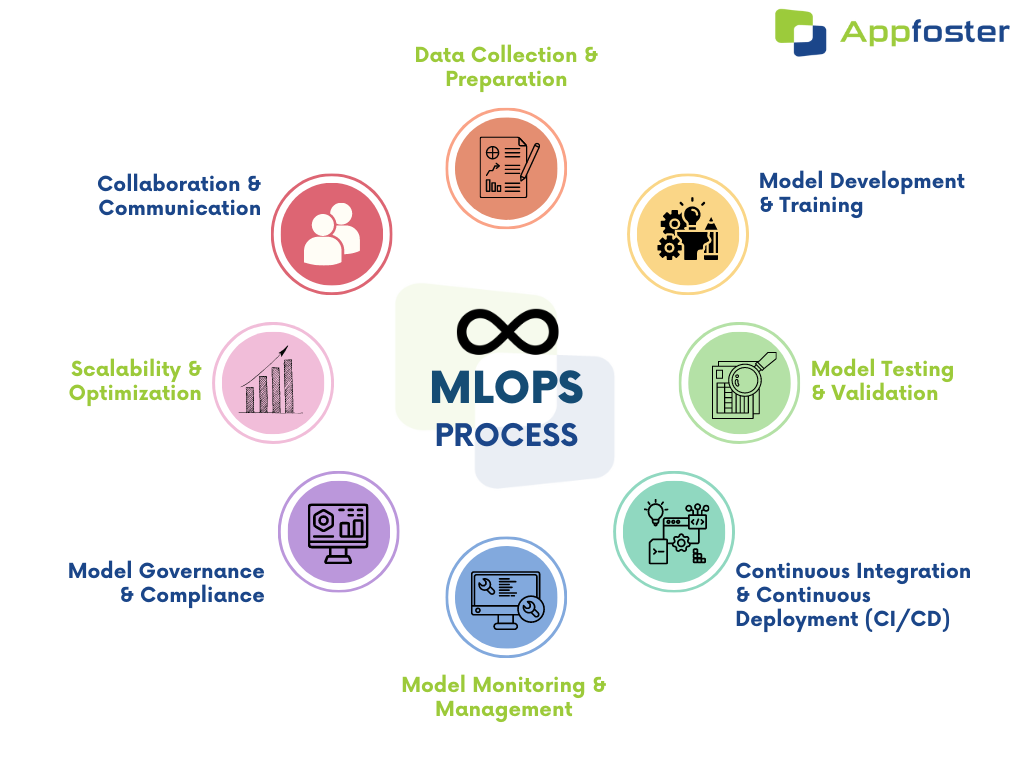MLOps Best Practices: Complete Roadmap To Refine Your Workflow

Machine learning has become indispensable for businesses of all sizes. However, efficiently and effectively constructing and deploying ML models at scale poses considerable challenges. This is where MLOps comes into play, applying DevOps principles to the realm of data science. In this blog, we will delve into the rise of MLOps, its importance, and its transformative influence on the field of data science.
MLOps, short for Machine Learning Operations, is the convergence of Machine Learning and Operations, akin to the union of Development and Operations (DevOps). Its primary objective is to optimize the ML lifecycle, which includes data preparation, model development, deployment, and monitoring. Moreover, by adopting collaborative and iterative principles, similar to DevOps, MLOps facilitates seamless integration among data scientists, engineers, and IT operations.
MLOps – The Process
Here’s a simplified overview of the MLOps process to achieve efficiency and impactful results:
1. Get the Data Ready
The first step in any ML project is gathering and preparing the data. Subsequently, MLOps teams work closely with data engineers to ensure data quality, adeptly handle missing values, and address any biases that might affect the model.
2. Building and Training the Model
Data scientists create and train ML models using the prepared data. Moreover, MLOps teams employ version control systems to track changes to the models and ensure reproducibility.
3. Rigorous Testing and Validation
Once the models are trained, they undergo rigorous testing and validation to check their accuracy and performance. In particular, automated testing plays a crucial role in ensuring the reliability of the models.
4. Automated Deployment with CI/CD
MLOps implement CI/CD pipelines to automate the deployment process. As a result, this allows models to be deployed to production quickly and efficiently whenever changes are made, reducing time-to-market and minimizing human errors.
5. Keeping an Eye on Things
Once the model is deployed, MLOps teams continuously monitor its performance in real-time. Additionally, they set up alerts to detect any anomalies or drops in accuracy, ensuring the model remains reliable.
6. Model Governance and Compliance
MLOps ensures that ML models meet ethical and regulatory standards. To achieve this, it involves tracking model usage, monitoring for biases, and maintaining compliance with data privacy regulations.
7. Scalability and Optimization
In response to growing AI demand, MLOps ensures ML infrastructure scalability to handle increased workloads. To accomplish this, techniques like containerization and cloud-based services may optimize resources.
8. Collaboration and Communication
MLOps promotes collaboration among data scientists, engineers, and operations teams throughout the process. Moreover, by fostering efficient communication, it ensures alignment, enabling a shared vision and unified efforts toward common objectives.

The benefits of MLOps
Faster and Agile: MLOps makes ML development and deployment a breeze by automating tasks and speeding up model iterations. Consequently, it enables businesses to stay nimble and respond swiftly to market changes.
Reliable and Accurate: With continuous monitoring and evaluation, MLOps ensures ML models are on point, effectively catching and fixing issues early on for top-notch accuracy and reliability.
Scalable and Adaptable: MLOps handles ML model management and deployment at scale, empowering businesses to take big data volumes and increased computational needs with ease.
Boosts Innovation and Experimentation: By automating the grunt work, MLOps enables data scientists to enhance their creativity, allowing them to focus on innovation and experimenting with powerful ML models.
The Challenges
Here are the challenges presented by MLOps that businesses need to navigate effectively:
Dealing with Data Complexity: ML models hunger for extensive and diverse data for training, which can be a real puzzle. Consequently, preparing and cleaning up the data to make it ML-ready can pose a challenge.
The Need for Technical Expertise: MLOps calls for a mix of talents, ranging from machine learning and DevOps to IT operations. Therefore, finding and retaining professionals with such a wide-ranging skill set can be a tough nut to crack for businesses.
Cultural Shift: Bringing MLOps on board means shaking things up culturally within organizations. Specifically, it’s all about fostering teamwork and collaboration across different departments, ensuring everyone is in sync for smooth development and deployment.
MLOps Tools and Platforms
Kubeflow: it is a scalable ML platform on Kubernetes, supporting end-to-end workflows and collaboration.
Metaflow: it simplifies data science projects with high-level API and scalability.
Amazon SageMaker: This is provided by AWS for data preprocessing, training, and experimentation, fostering collaboration and scalability.
Microsoft Azure ML: It offers a collaborative workspace with pre-built models and automated tasks for efficient ML projects.
Google Cloud Vertex AI: It provides an environment for automated and custom model training, with built-in components for scalability.
Databricks: It is a cloud-native platform for big data processing and ML, ideal for enterprise-grade projects.
How to Dive into MLOps?
Set Clear Goals
To begin with, articulate your objectives and craft a strategic plan to achieve them through the implementation of MLOps.
Check Your Capabilities
Before diving deeper, conduct an assessment of your current strengths and weaknesses in machine learning, DevOps, and IT ops. Identify areas that require improvement and prepare for progress accordingly.
Pick the Right Tools
Next, meticulously choose tools and technologies that align seamlessly with your business needs. There is an array of options available to elevate your MLOps game.
Build the Dream Team
Assemble a dream team, encompassing diverse skills such as machine learning engineers, DevOps wizards, and IT operations champs.
Roll Out MLOps Processes
Once you’ve assembled the team and acquired the tools, it’s time to put your plans into action. Consequently, implement MLOps processes for data preparation, model training, evaluation, deployment, and monitoring.
Wrap-up
Implementing MLOps proves to be a transformative force, revolutionizing the approach to ML model development and deployment for organizations. By incorporating DevOps principles into data science workflows, MLOps facilitates seamless collaboration, scalability, and robust model governance. As AI and ML continue to reshape industries globally, the convergence of MLOps and innovation becomes the path toward a promising future.
At Appfoster, we are at the forefront of the MLOps revolution, guiding businesses on their journey to AI excellence. Additionally, our dedicated team of experts combines deep knowledge in AI, DevOps, and Data Science to provide customized MLOps solutions that fit your unique requirements. Get in Touch!

